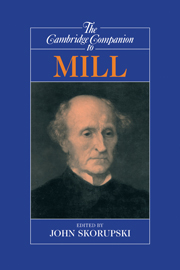Book contents
- Frontmatter
- Introduction
- 1 Mill on language and logic
- 2 Mill, mathematics, and the naturalist tradition
- 3 Mill on induction and scientific method
- 4 Mill, phenomenalism, and the self
- 5 Mill on religion
- 6 Mill on psychology and the moral sciences
- 7 Mill's utilitarianism
- 8 Mill's political economy
- 9 Civilization and culture as moral concepts
- 10 Democracy, socialism, and the working classes
- 11 The subjection of women
- 12 Mill and the Classical world
- 13 The reception and early reputation of Mill's political thought
- 14 Mill in a liberal landscape
- Guide to further reading
- Bibliography
- Index
11 - The subjection of women
Published online by Cambridge University Press: 28 May 2006
- Frontmatter
- Introduction
- 1 Mill on language and logic
- 2 Mill, mathematics, and the naturalist tradition
- 3 Mill on induction and scientific method
- 4 Mill, phenomenalism, and the self
- 5 Mill on religion
- 6 Mill on psychology and the moral sciences
- 7 Mill's utilitarianism
- 8 Mill's political economy
- 9 Civilization and culture as moral concepts
- 10 Democracy, socialism, and the working classes
- 11 The subjection of women
- 12 Mill and the Classical world
- 13 The reception and early reputation of Mill's political thought
- 14 Mill in a liberal landscape
- Guide to further reading
- Bibliography
- Index
Summary
When John Stuart Mill married Harriet Taylor in 1851, he wrote out a formal protest against the laws that would govern their marriage. He objected to
the whole character of the marriage relation as constituted by law... for this amongst other reasons, that it confers upon one of the parties to the contract, legal power & control over the person, property, and freedom of action of the other party, independent of her own wishes and will.... [Having no means of legally divesting myself of these odious powers . . . [I] feel it my duty to put on record a formal protest against the existing law of marriage, in so far as conferring such powers; and a solemn promise never in any case or under any circumstances to use them.' (Hayek 1951, 168)
This critique of the injustices of English marriage law formed the core of Mill's later work, The Subjection of Women. Although The Subjection of Women was enthusiastically welcomed and widely circulated among the small circles of women's rights advocates on both sides of the Atlantic in the latter nineteenth century, beyond these groups when the book was not ignored it was frequently ridiculed or excoriated by philosophers and politicians alike. James Fitzjames Stephen, one of the foremost jurists of the century, wrote that he disagreed with The Subjection of Women “from the first sentence to the last” (Stephen 1873/1967, 188).
- Type
- Chapter
- Information
- The Cambridge Companion to Mill , pp. 396 - 422Publisher: Cambridge University PressPrint publication year: 1998
- 6
- Cited by

